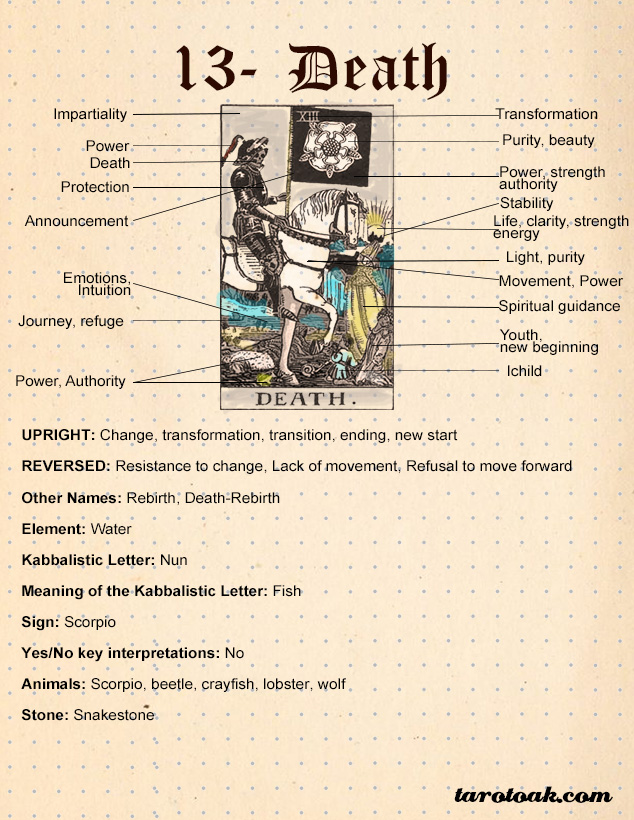Love is often thought of as a sanctuary, a nurturing force guiding individuals toward fulfillment and connection. Yet, when the Death tarot card appears within the realm of love readings, it introduces a paradoxical element—a harbinger of transformation that may instigate fear and intrigue simultaneously. The presence of this card invites a deeper exploration of its intricate symbolism, particularly within romantic contexts. How might the concept of ‘death’ in love not signify an end, but rather, a poignant beginning?
To delve into the Death tarot card’s meaning in love, one must first grasp its overarching symbolism. Traditionally adorned with skeletal imagery or figures beleaguered by the inevitabilities of mortality, this card often evokes apprehension. However, its true essence lies in metamorphosis. Within relationships, the Death card may represent a significant transition, urging one to shed outdated patterns and embrace rejuvenation. This leads to the pivotal question: what aspects of your relationship might need to be relinquished to usher in growth?
Understanding the Death card in the context of love prompts a thorough examination of its implications. A relationship that feels stagnant or burdensome can be likened to a wilting flower, desperately in need of fresh air and new soil. The Death card catalyzes a critical dialogue around letting go—whether that means shedding toxicity, relinquishing unreciprocated affections, or simply allowing space for personal evolution. Thus, as daunting as the concept may seem, it challenges couples to confront the uncomfortable truths that may lie beneath the surface.
In romantic partnerships, the transition symbolized by the Death card can manifest in several ways. An important aspect to consider is the archetype of closure. If one partner has been clinging to past grievances or unresolved conflicts, the Death card serves as a beckoning call to engage in earnest reflection. Embracing closure often allows for a newfound appreciation of the relationship’s journey, transforming pain into wisdom. It begs the question: how can you cultivate a sense of healing amidst lingering shadows?
A practical manifestation of the Death card can also be seen in the inception of new relationships. An individual emerging from an initial heartbreak may encounter the card’s energy when they least expect it. In this instance, it does not signify the end of their romantic endeavors; rather, it epitomizes the potential for reinvention. By learning from past heartaches, individuals can approach new relationships with fresh perspectives, unmarred by previous disappointments. Here arises another challenge: how can you break free from past emotional traps to fully embrace the present?
Moreover, the Death card emphasizes the importance of acceptance within love. Relationships undergo cycles—some flourish while others wither. This inherent fluidity underlines the necessity for acceptance of change. Acknowledging that nothing remains static creates room for personal growth and collective evolution within a partnership. This brings us to a contemplative question: what change in your partner or relationship are you reluctant to accept that may actually serve a greater purpose?
The role of the Death card also highlights the tenuous balance between passion and control. Love, while often passionate and exhilarating, can also stifle individual progression when one seeks to dominate or control another. Here, the Death card nudges individuals to examine their behavior and its impact on the relationship’s dynamics. Are you allowing love to flourish, or are you inadvertently suffocating it with expectations? Such reflections catalyze a decisive moment of truth, capable of morphing a struggling relationship into one grounded in mutual respect.
It’s essential to consider the Death card’s connection to introspection. For many, it invokes an inward journey, prompting them to explore personal desires and needs within the context of their relationships. A cycle of continuous self-exploration can yield profound insights. Do you prioritize your own aspirations, or do they often get lost amidst the demands of your partnership? Pondering this question allows the individual to reclaim their identity, which in turn, enhances the relational dynamic.
The essence of transformation also resonates with the idea of embracing impermanence. Love is not a possession; rather, it is a fluid experience that is enriched by its precariousness. The Death card urges lovers to savor moments, understanding that the beauty of love lies not in its permanence, but in its inevitable evolution. This invites a thought-provoking stance—are you placing undue pressure on your relationship to conform to a predetermined narrative?
Ultimately, the Death tarot card signifies that endings and beginnings are two sides of the same coin. In a love reading, it illuminates paths toward liberation and renewal. Rather than viewing this card with trepidation, consider its invitation for profound reflection, candid conversations, and emotional openness. The energy of the Death card can forge space for rebirth, fostering relationships that are healthier, more authentic, and aligned with both partners’ deepest truths.
As you navigate the complex landscapes of love, remember that the representation of ‘death’ within tarot transcends mere finality; it harbors the potential for rebirth and rejuvenation. Embrace the lessons, confront fears, and welcome the transformative power of love’s darkest corners. What legacy will you create as you step boldly into embracing change?









Leave a Comment